Imagine one of those old-timey lumberjack photos. The kind where two men in plaid are working away at a tree, holding opposite ends of a huge, human-length saw. That is a vintage crosscut saw. Some avid crosscut seekers spend hours mining websites like eBay and Craigslist. But they also search in person on saw hunting road trips — driving up and down Highway 49 to stop by yard sales, antique stores, and even places where the saws aren’t technically for sale, like: the walls of local restaurants where they are displayed as decor.
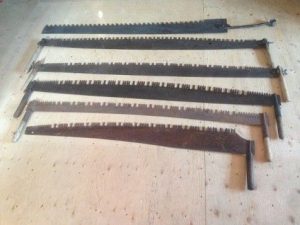 On its face, it may seem a little intense to care about old saws so much that you end up trying to barter with your Cracker Barrel server because they have a wall decoration you just really want to take home. But the vintage crosscuts that backcountry stewards go hunting for aren’t just for show. Often, the plan is to put the saw back to use. After the paint has been scrubbed clean and the teeth have been sharpened, many return to the woods, bucking and felling trees in the American outdoors. In fact, thousands of trail workers use these vintage crosscuts today, to make trails and clear trees.
On its face, it may seem a little intense to care about old saws so much that you end up trying to barter with your Cracker Barrel server because they have a wall decoration you just really want to take home. But the vintage crosscuts that backcountry stewards go hunting for aren’t just for show. Often, the plan is to put the saw back to use. After the paint has been scrubbed clean and the teeth have been sharpened, many return to the woods, bucking and felling trees in the American outdoors. In fact, thousands of trail workers use these vintage crosscuts today, to make trails and clear trees.
Vintage crosscuts that were made between 1880 and 1930 are often the tool of choice for trail workers who maintain the country’s roughly 112 million acres of protected land. That’s ahead of chain saws and newly made crosscuts. And the reason this old tool has stuck around so long — even in an age when there’s a newer, better gadget coming out every year — it goes way beyond the physical saw itself. The rise, fall, and unexpected second life of the crosscut saw is also the story of how America created the very concept of wilderness.
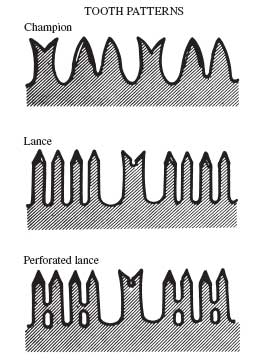 European settlers defined themselves in opposition to indigenous people. So the idea was, starting in the 17th century, white people lived in civilization, and indigenous people lived in the hostile wilderness. And for 200 years, that’s how it went: wilderness didn’t have the greatest reviews. Industrialization created the conditions for certain things to grow chaotically and exponentially – things like cities, factories, pollution, a working class. It shattered the old patterns of rural life and brought on new ways of relating to land. And it sparked the beginning of a reorientation of what un-industrialized spaces could do for people.
European settlers defined themselves in opposition to indigenous people. So the idea was, starting in the 17th century, white people lived in civilization, and indigenous people lived in the hostile wilderness. And for 200 years, that’s how it went: wilderness didn’t have the greatest reviews. Industrialization created the conditions for certain things to grow chaotically and exponentially – things like cities, factories, pollution, a working class. It shattered the old patterns of rural life and brought on new ways of relating to land. And it sparked the beginning of a reorientation of what un-industrialized spaces could do for people.
As steam and coal power came on the scene, cities got bigger, noisier, and more polluted. “Wilderness” became more and more appealing as a contrast to the pressures of industrial capitalism. Wild spaces were now being described as pure, instead of scary. Safe instead of savage. No longer an unfarmed wasteland, but more of a temple – something of value to humans that needed to be protected from humans.
By the Romantic Era, American writers like Ralph Waldo Emerson and Henry David Thoreau believed that wilderness was a creation of God that provided important space for intellectual stimulation; a place where ‘good’ men could become ‘great’ men. A famous photographer named Ansel Adams became known for his landscape photos of the American West, particularly Yosemite National Park. Adams helped propel the idea that America’s great wilderness was a point of pride and national identity.
But at the time, the idea of wilderness was still mostly an intellectual and artistic concept discourse. Actual wild places weren’t accessible to the masses yet, or even associated as a place to go on a family vacation. That started to change in the early 1900s when Teddy Roosevelt was inaugurated as President. Roosevelt established the Forest Service and Park Service, and America’s wild spaces started to gain national attention. An outdoor recreation movement took off that would only grow and grow and grow as Americans hiked, canoed and camped their way into the first decades of the 20th century. Wilderness became a place where not just wealthy artists, but everyday Americans could find the promise of health, relaxation, and moral regeneration.
In order to get as many tourists as possible into these Parks, the government went hard on building roads. And all this development meant that the crosscut saw was in extremely high demand. These saws were being churned out in huge numbers by manufacturers who were selling newer models every year. By the Great Depression, tens of thousands of Americans were put to work, many of them wielding the crosscut to clear trails and lay down miles and miles of pavement.
By this time, about a million cars were being sold in the country each year, many of their owners eager to drive down the newly constructed Yellowstone Highway which connected 13 National Parks by road. From Yellowstone you could drive North to Glacier, West to the Cascades, South through the Sierras, and east past the Grand Canyon.
But the success of these efforts troubled some of those early celebrators of the wild. With all these roads and tourism, it seemed to them that wilderness was at risk of losing its moral character, its purity. The unique quality of wilderness was that it existed outside of human life. So if all these pristine landscapes would one day be rolled over by hundreds of cars a day, was that wilderness at all?
Meanwhile, World War II and the urgent need for efficiency pushed the chainsaw into the hands of loggers. And since most loggers at the time were paid per tree cut, chainsaws were pretty appealing. Picture hundreds of crates of crosscut saws being pushed to the back of warehouses because no one wanted them anymore. Eventually, these tools found their way to antique stores or someone’s basement eBay business. Others found new purpose as wall decoration.
In 1964, Congress passed The Wilderness Act, and America did something no other country had ever done: it passed a law to protect land and preserve it in its natural state. The act brought about some major changes because of the way it defined wilderness. On top of being untrammeled, capital W wilderness was now an area without mechanization and the presence of motors. So in a federally designated wilderness area, there are no snowmobiles, motorboats, bicycles, or cars allowed. And for the hundreds of people who work in the American wilderness today, this means they can’t use jackhammers, powered rock drills, or chainsaws. Crosscuts first made a comeback because they had to, but now they’re increasingly desirable even in non-wilderness areas where chainsaws are technically allowed.
Ever since the crosscut revival, the vintage saw has become harder to find, especially as some are being snatched up by collectors or competitive lumberjacks. Many others are kept as family heirlooms. These days, new crosscut saws are being manufactured again. There’s at least one manufacturer in the US churning out new, modern-day crosscuts, available for purchase online. And yet, trail workers often find they strongly prefer the antique crosscut saw.
 In 2005, The Forest Service even published a study comparing the quality of vintage and modern saws, favoring the older ones. These old saws are made from a higher quality steel and the teeth are set in a crescent-shaped arc. So there are practical arguments that they do cut better. But there’s also clearly an element of nostalgia in play.
In 2005, The Forest Service even published a study comparing the quality of vintage and modern saws, favoring the older ones. These old saws are made from a higher quality steel and the teeth are set in a crescent-shaped arc. So there are practical arguments that they do cut better. But there’s also clearly an element of nostalgia in play.
There’s a certain romantic idea to using a vintage crosscut saw that feels really similar to the romance Aldo Leopold and others felt about wilderness in the 19th century. The pursuit of something untouched, unsullied by contact with humans and industry.
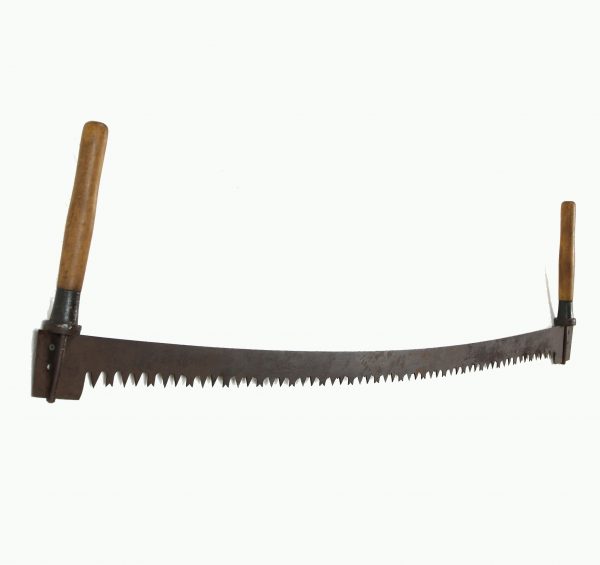
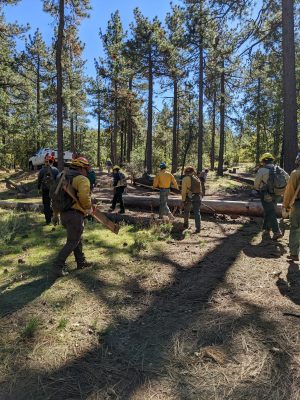

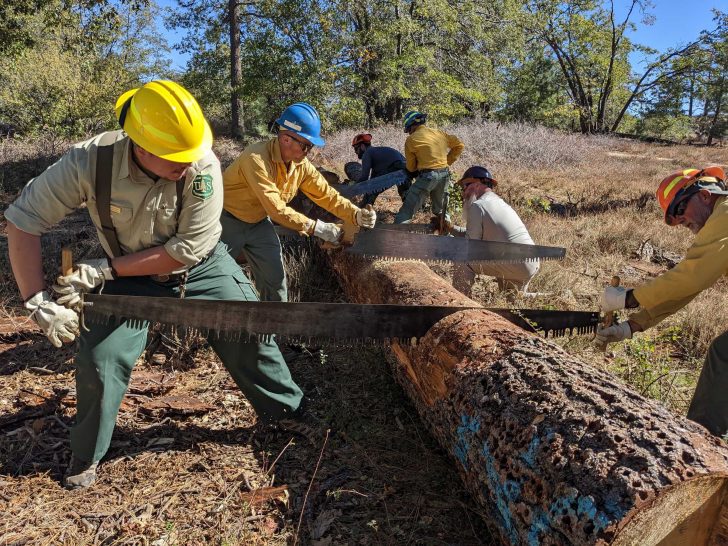



Comments (5)
Share
Loved this episode. I was absolutely astonished to learn about the ban on wheels. Doesn’t the same logic apply to all simple machines then? Shovels are just levers attached to wedges, saws are just a bunch of wedges in a row. By the logic given basically existing in the wilderness should be banned.
This is really a fabulous episode!
I’ve sent it along to tons of family and friends.
Absolutely brilliant job by all your participants. Great storytelling and so unexpected. Thank you so much.!!
Great episode, but I couldn’t contain myself hearing that wheelbarrows were not allowed because the wheel (and axle) is one of the six simple machines!
Really?
Because the cross-cut saw is nothing other than a long line of tiny wedges, so is an axe. A crowbar is a lever, and skis and sleds use an inclined plane to reduce friction. I’d be surprised if they don’t use a hand-brace for screws and pulleys to round out all the other five simple machines….
Call me an Australian that doesn’t understand your wilderness rules when it comes to wheels…, but otherwise I just loved this story and plan to look out for an old cross-cut saw to join my tool collection!
In your journey down the rabbit hole for this one, I’m curious if you ran into anyone arguing that use of saws and axes should also be disallowed? Since technically, they both use wedges, another type of simple machine. Maybe I’m “splitting” hairs by reading into the simple machines discussion too much. :-)
Great episode as always! I wish you had dug in a little bit more on this idea of simple machines and specifically wheels not being allowed in Wilderness areas. The wedge, as in a saw or axe is also considered a simple machine but clearly the forest service has no issues with those. Just wondering how they came to this odd definition of “mechanized” that includes wheels but not wedges.